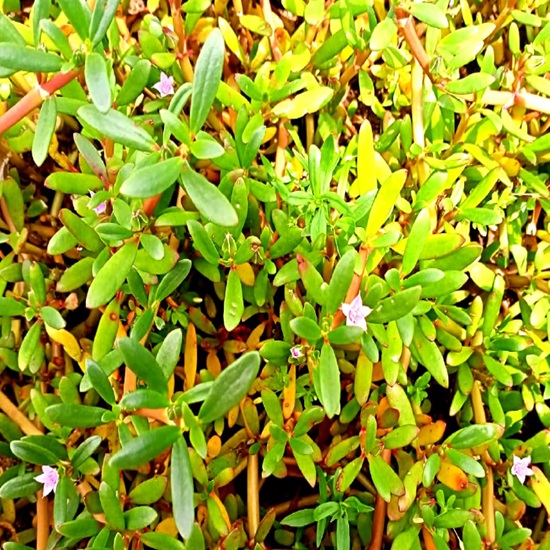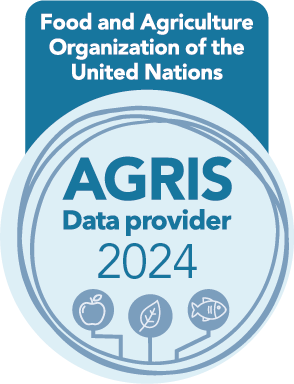Comparative analysis of seed dormancy breaking methods in Sesuvium portulacastrum (L.) L.
DOI:
https://doi.org/10.14719/pst.5412Keywords:
dormancy-breaking methods, germination enhancement, hard seed coat, seed formancy, sulfuric acid treatmentAbstract
Seed dormancy is a significant challenge that hinders the successful germination of Sesuvium portulacastrum, a halophytic species with promising applications in phytoremediation and coastal stabilization. This study aims to evaluate the efficacy of several dormancy-breaking treatments on the germination of S. portulacastrum seeds. The treatments assessed include potassium nitrate, sulfuric acid, manual scratching, hot water treatment and gibberellic acid (GA?) in promoting the germination of S. portulacastrum seeds. Each treatment was applied to seeds and germination rates were monitored to determine effectiveness. The results revealed that the treatment with concentrated sulfuric acid for 2 min significantly enhanced germination rates compared to the other methods tested. This method outperformed the others, highlighting its potential as an effective protocol for overcoming dormancy in S. portulacastrum. The findings of this research provide important insights into optimizing germination protocols for this species, which can contribute to its broader use in environmental applications, particularly in restoring degraded coastal areas and improving soil stability. By breaking seed dormancy effectively, S. portulacastrum can be utilized more effectively in restoration projects aimed at addressing environmental degradation and enhancing ecosystem resilience. Overall, this study underscores the importance of understanding and manipulating seed dormancy to promote the use of halophytic species in ecological restoration efforts.
Downloads
References
Lokhande, Vinayak H. Structural hierarchy imparts salinity stress tolerance improvement in the halophyte Sesuvium portulacastrum L. Physiology of Halophytes: Signaling, Omics and Tolerance Mechanisms. 2025; 1777. https://doi.org/10.1201/9781003504085-11
Alsherif, Emad A, Turki M Al-Shaikh, Omar Almaghrabi, Hamada AbdElgawad. High redox status as the basis for heavy metal tolerance of Sesuvium portulacastrum L. inhabiting contaminated soil in Jeddah, Saudi Arabia. Antioxidants. 2021;11(1): 19. https://doi.org/10.3390/antiox11010019
Parida, Kumar A, Kumari A, Rangani J, Patel M. Halophytes: potential resources of coastal ecosystems and their economic, ecological and bioprospecting significance. In: Halophytes and climate change: adaptive mechanisms and potential uses; 2019. pp. 287?323. Wallingford UK: CABI. https://doi.org/10.1079/9781786394330.0287
Martínez ML, Valverde T, Moreno-Casasola P. Germination response to temperature, salinity, light and depth of sowing of ten tropical dune species. Oecologia. 1992;92: 343?53. https://doi.org/10.1007/BF00317460
Hafeez, Bilal M, Raza A, Zahra N, Shaukat K, Akram MZ, et al. Gene regulation in halophytes in conferring salt tolerance. In: Handbook of bioremediation; 2021. pp. 341?70. Academic Press. https://doi.org/10.1016/B978-0-12-819382-2.00022-3
Schmidt L. Seed dormancy and presowing treatment. Tropical Forest Seed. 2007;199–245. https://doi.org/10.1007/978-3-540-68864-8_5
Kheloufi A, Mansouri L, Aziz N, Sahnoune M, Boukemiche S, Ababsa B. Breaking seed coat dormancy of six tree species. Reforesta. 2018;(5):4–14. https://doi.org/10.21750/REFOR.5.02.48
Gupta SR,. Dagar JC, Sharma HR. Halophytes and agroforestry in the restoration of salt-affected landscapes in changed environment. J of Soil Salinity and Water Quality. 2024;16(2):152?65. https://doi.org/10.56093/jsswq.v16i2.156303
Sivakumar T. An updated review of Psidium guava L. miracle plants, ethnomedicine, tea preparation and pharmacological applications. Inter J of Engineering Tech and Manag Sci. 2024;8(6):30337. https://doi.org/10.46647/ijetms.2024.v08i06.005
Roe, Rebecca AL, MacFarlane GR. The potential of saltmarsh halophytes for phytoremediation of metals and persistent organic pollutants: An Australian perspective. Marine Pollution Bul. 2022; 180:113811. https://doi.org/10.1016/j.marpolbul.2022.113811
Khan MA, Weber DJ. Ecophysiology of high salinity tolerant plants. Vol. 40. Springer Sci and Business Media; 2006. https://doi.org/10.1007/1-4020-4018-0
Baskin JM, Baskin CC. Seed germination in cleistogamous species: theoretical considerations and a literature survey of experimental results. Seed Sci Res. 2017;27(2):84–98. https://doi.org/10.1017/S0960258517000058
Baskin JM, Nan X, Baskin CC. A comparative study of seed dormancy and germination in an annual and a perennial species of Senna (Fabaceae). Seed Sci Res. 1998;8(4):501–12. https://doi.org/10.1017/S0960258500004475
Ahmadnia F, Alebrahim MT, Nabati Souha L, MacGregor DR. Evaluation of techniques to break seed dormancy in redroot pigweed (Amaranthus retroflexus). Food Sci and Nutri. 2024;12(4):2334?45. https://doi.org/10.1002/fsn3.3920
Duermeyer L, Khodapanahi E, Yan D, Krapp A, Rothstein SJ, Nambara E. Regulation of seed dormancy and germination by nitrate. Seed Sci Res. 2018;28(3):150–57. https://doi.org/10.1017/S096025851800020X
Bethke PC, Libourel IGL, Jones RL. Nitric oxide reduces seed dormancy in Arabidopsis. J Exp Bot. 2006;57(3):517–26. https://doi.org/10.1093/jxb/erj060
Siraree A, Misra V. Seed dormancy. Adv in Seed Prod and Manage. 2020;283–306. https://doi.org/10.1007/978-981-15-4198-8_13
Murti? S, Gavri? T, Hasanbegovi? A, Avdi? J, Be?i? B, Šerbo A. Dormancy-breaking treatments for enhancing seed germination in plant Kitaibela vitifolia Willd. Acta Agric Slov. 2023;119(1):1–8. https://doi.org/10.14720/aas.2023.119.1.2890
Rao V, Petla BP, Verma P, Salvi P, Kamble NU, Ghosh S, et al. Arabidopsis SKP1-like protein13 (ASK13) positively regulates seed germination and seedling growth under abiotic stress. J Exp Bot. 2018;69(16):3899–915. https://doi.org/10.1093/jxb/ery191
Acosta Y, Escobar-Gutiérrez A, Ahmed LQ, Cejas I, Martínez-Montero ME, Sánchez J, et al. Morpho-anatomical evaluation of Teramnus labialis seeds: strategies to overcome physical dormancy. Biologia (Bratisl). 2023;78(8):2003–11. https://doi.org/10.1007/s11756-023-01341-6
Holmberg K, Matthews A. Coatings tribology: properties, mechanisms, techniques and applications in surface engineering. Elsevier; 2009.
Baskin CC, Baskin JM. Breaking seed dormancy during dry storage: a useful tool or major problem for successful restoration via direct seeding? Plants. 2020;9(5):636. https://doi.org/10.3390/plants9050636
Denton OA, Schippers RR, Oyen LPA. Plant resources of tropical Africa, 2: Vegetables. Fondation PROTA, Wageningen, Pays-Bas/CTA, Wageningen Pays-Bas. 2004;522–26.
Engelmann F. In vitro conservation methods. Biotech in Agri Series. 1997;119–62.
Bewley JD, Bradford KJ, Hilhorst HWM, Nonogaki H, Bewley JD, Bradford KJ, et al. Germination. Seeds: Physiology of development, germination and dormancy, 3rd Edition. 2013;133–81. https://doi.org/10.1007/978-1-4614-4693-4_4
Herranz JM, Ferrandis P, Martínez-Sánchez JJ. Influence of heat on seed germination of seven Mediterranean Leguminosae species. Plant Ecol. 1998;136:95–103. https://doi.org/10.1023/A:1009702318641
Koobonye M, Maule BV, Mogotsi K. Mechanical scarification and hot water treatments enhance germination of Leucaena leucocephala (Lam.) seeds. Livest Res Rural Dev. 2018;30(1):1–7.
Skubacz A, Daszkowska-Golec A. Seed dormancy: the complex process regulated by abscisic acid, gibberellins and other phytohormones that makes seed germination work. Phytohormones—Signaling Mechanisms and Crosstalk in Plant Development and Stress Responses. 2017;77–100. https://doi.org/10.5772/intechopen.68735
Rodrigues-Junior AG, Faria JMR, Vaz TAA, Nakamura AT, José AC. Physical dormancy in Senna multijuga (Fabaceae: Caesalpinioideae) seeds: the role of seed structures in water uptake. Seed Sci Res. 2014;24(2):147–57. https://doi.org/10.1017/S0960258514000087
Skogerboe D. Seed Dormancy in Callirhoe involucrata (Torr. & Gray) Gray, (Malvaceae). Colorado State University; 2001.
Balouchi HR, Sanavy S. Effect of gibberellic acid, prechilling, sulfuric acid and potassium nitrate on seed germination and dormancy of annual Medics. Pak J of Bio Sci. 2006;9(15):2875–80. https://doi.org/10.3923/pjbs.2006.2875.2880
Kimura E, Fransen SC, Collins HP, Guy SO, Johnston WJ. Breaking seed dormancy of switchgrass (Panicum virgatum L.): a review. Biomass Bioenergy. 2015;80:94–101. https://doi.org/10.1016/j.biombioe.2015.04.036
Ghosh D, Mondal S, Ramakrishna K. A topical ointment formulation containing leaves extract of Aegialitis rotundifolia Roxb., accelerates excision, incision and burn wound healing in rats. Wound Med. 2019;26(1):100168. https://doi.org/10.1016/j.wndm.2019.100168
Toora ,Parneet. Genetic and molecular bases of abscisic acid and gibberellin metabolism in regulating seed dormancy in malting barley.2018.
Panda BM, Hazra S. Seedling culture of Semecarpus anacardium L. Seed Sci Biotechnol. 2009;3(2):54–59.
Koyro HW, Lieth H, Gul B, Ansari R, Huchzermeyer B, Abideen Z, et al. Importance of the diversity within the halophytes to agriculture and land management in arid and semiarid countries. Sabkha ecosystems: volume IV: cash crop halophyte and biodiversity conservation. 2014;175–98. https://doi.org/10.1007/978-94-007-7411-7_12
Heneidy SZ, Laila MB, Marwa WAH, Amal MF, Soliman MT, Eman TK. Naturalization and invasion potential of Sesuvium portulacastrum L. recorded as alien species in Egypt. Scientific Reports. 2024;14(1):3117. https://doi.org/10.1038/s41598-024-53627-7

Downloads
Published
How to Cite
Issue
Section
License
Copyright (c) 2025 Siva Raja Sritha Kamaraj Geetha, Boomiraj Kovilpillai, Dhevagi Periyasamy, Manonmani Velusamy , Jagadeeswaran Ramasamy

This work is licensed under a Creative Commons Attribution 4.0 International License.
Copyright and Licence details of published articles
Authors who publish with this journal agree to the following terms:
- Authors retain copyright and grant the journal right of first publication with the work simultaneously licensed under a Creative Commons Attribution License that allows others to share the work with an acknowledgement of the work's authorship and initial publication in this journal.
- Authors are able to enter into separate, additional contractual arrangements for the non-exclusive distribution of the journal's published version of the work (e.g., post it to an institutional repository or publish it in a book), with an acknowledgement of its initial publication in this journal.
Open Access Policy
Plant Science Today is an open access journal. There is no registration required to read any article. All published articles are distributed under the terms of the Creative Commons Attribution License (CC Attribution 4.0), which permits unrestricted use, distribution, and reproduction in any medium, provided the original author and source are credited (https://creativecommons.org/licenses/by/4.0/). Authors are permitted and encouraged to post their work online (e.g., in institutional repositories or on their website) prior to and during the submission process, as it can lead to productive exchanges, as well as earlier and greater citation of published work (See The Effect of Open Access).









